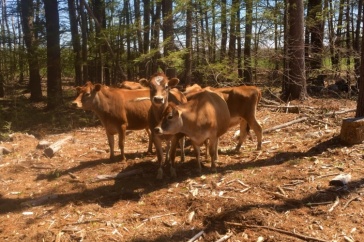It’s a question that sounds like the setup to a joke — how many winter ticks can fit on one moose? — but the answer is anything but funny.
“The first snowfall is key to limiting how many ticks can get on a moose, and as the winters are starting later and later, the tick loads are getting higher and higher.”
For the past four years, UNH professor of wildlife biology Pete Pekins has been tracking the decline of New Hampshire’s moose population at the hands of the winter tick, a parasite that infests the animals in loads in excess of 50,000 each and causes substantial hair loss, severe blood and weight loss and acute anemia. The effect on younger moose is particularly dire; high infestations in early spring may cause moose calves to lose their entire blood volume in a matter of weeks, and Pekins and his team have measured mortality in excess of 70 percent for 10–11 month old calves. That’s a statistic that has alarming implications for the herd itself, and also for the economic vitality of New Hampshire’s North Country, where the iconic ungulate is a mainstay of the ecotourism industry.
Since 2014, Pekins and his team have been at the center of the largest study of New England moose ever conducted; a three-state, UNH-alumni-heavy effort that spans Maine, New Hampshire and Vermont. From 2014–2017, Pekins’ team worked with the New Hampshire Fish and Game Department to capture and radio-collar approximately 45 moose cows and calves each year, collecting blood, hair and feces — and ticks. The study is yielding important data on how calf mortality and adult moose productivity are affected by tick loads and helping to explain interrelationships among the parasite, moose density, habitat and weather.


Pekins says it’s already possible to draw straight lines that connect higher calf mortality and lower herd productivity to the later-starting winters that have occurred more frequently in recent years.
“The first snowfall is key to limiting how many ticks can get on a moose,” Pekins explains, “and as the winters are starting later and later, the tick loads are getting higher and higher.” Unlike deer, moose lack the ability to groom ticks from their bodies, and rely on snow and cold to kill the tick larvae that live in the vegetation, waiting to hitch a ride and a meal. “The irony is that what we might call a hard winter in northern New Hampshire is an easy winter for a moose.”
With the ultimate goal of facilitating a healthy moose population, Pekins and his team are studying the weather, moose density and productivity, local habitat conditions and even soil fungi that are lethal to tick larvae to better understand the drivers of the current moose decline. While New Hampshire isn’t on a path to lose its moose population entirely (indeed, last year’s September drought and mid-November snow led to significantly lowered tick loads and a survival rate of 70 percent for 2016-born calves, and this summer Pekins spotted a set of twin calves, the first since the study launched) Pekins puts the state’s current herd at some 4,000 animals, down from 7,500 in the early 2000s, and notes that if numbers continue falling, the range of New England moose is likely to shift farther north.
While there are significant economic considerations to protecting the Granite State moose population — wildlife watchers spend an estimated $250 million annually in northern New Hampshire — Pekins says his work is fueled primarily by a passionate interest many New Englanders share in the gangly, antlered animal. “It is a very short story that we hope to keep going,” he says. The research team will be capturing 50 more moose in January 2018, the last scheduled capture on the project.
Originally published in UNH Magazine Winter 2018 Issue


















































